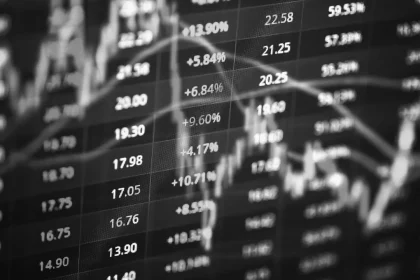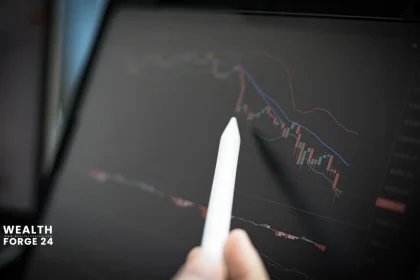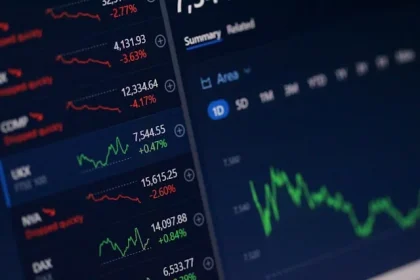Trading the market means buying and selling financial tools to make money. In this guide, we cover the main parts of financial markets. We also explain how to execute trades. You’ll learn the basics of buying and selling. This includes risk and reward. You’ll also grow your skills to identify opportunities in the market.
What is trading?
Understanding what trading means is essential to monetary fulfillment. Financial buying and selling means looking for and selling securities, property, or financial tools to make money. Trading involves buying and selling gadgets. Their values change due to various market factors and economic conditions.
Trading lets you guess market moves and fee paths. Depending on your chosen product, you can benefit from falling costs and rising prices.
You can choose from many markets and a wide range of products to change them.
Is trading the same as investing?
The key difference between trading and investing is the timeframe and approach. Investors seek short-term profits, while traders focus on long-term growth.
Trading the market means buying and selling quickly. You aim to profit from fast changes in an asset’s price. Traders enter and exit positions in a matter of days, hours, or maybe minutes.
Day traders buy and sell within one trading day. They represent the most active group in the short-term market. Swing trading can last several days or even weeks. It captures medium-term price changes between support and resistance levels.
Position buying and selling means protecting trades for months. It mixes active trading with long-term investments. Long-term buying and selling strategies need patience. They can reduce the stress of constantly watching the market. To day trade, you need to grasp intraday rate changes and manage positions during market hours.
Investors often focus on how appearance relates to income over time. Because of this, it’s common to keep assets for several years before selling them.
Due to how buying and selling work, those trying to profit in the markets often use smaller amounts. However, they will only succeed if they are skilled. Investors should expect bigger gains, but they usually need to stay invested longer.
Which technique is riskier?
Buying and selling are often seen as riskier. This view comes from marketplace volatility, market fluctuations, and unpredictability. Investing can be risky. Investors often avoid losses from short-term market dips. This is because protecting assets takes time.
Monetary trading requires skill and knowledge. It’s especially important when using techniques like technical and fundamental analysis. Effective market analysis combines both technical chart patterns and essential financial factors.
What are economic markets?
A financial marketplace lets you buy and sell money securities. It offers platforms where investors can enter and exit positions, either online or in person.
These markets, or exchanges, may be structures, of which there are a large number, every one related to exclusive kinds of belongings.
Monetary markets include the stock market, foreign exchange market, and commodities market. The New York Stock Exchange (NYSE) and London Stock Exchange are famous markets. They have places where people buy and sell economic securities, like company shares. Today, most investors buy and sell online. They use advanced trading platforms that allow them to enter the market in real time.
Trading via regulated exchanges is the most commonplace technique, but it is also feasible to trade over the counter (OTC). This refers to trades occurring within a dealer-supplier community. It does not happen on a centralized exchange, like the New York Stock Exchange. Online trading has changed how people access markets. Now, retail buyers can join international markets from anywhere. Modern economic services have made buying and selling more accessible and less expensive than ever before.
Which items can we trade?
You can exchange many assets, like shares, forex, and commodities.
- Stocks: Trading in the stock market means buying and selling shares of listed businesses. Stocks can be classified as regular or preferred. They also fall into categories like large, mid, or small cap, and domestic or international. Stocks may be traded through multiple strategies via a broker on an internet platform. Individual investors can buy and sell shares using various strategies. They do this through brokers on online platforms, gaining access to many listed companies. Success relies on accurately predicting stock prices. It also hinges on timing, access, and go-out factors effectively.
- Forex: Also called forex, this market is where foreign money trades. It’s the most liquid marketplace globally. Currency buying and selling takes place in pairs, in which they’re traded against each other. You can examine more in our guide to foreign money pairs.
- Commodities: Trading natural, uncooked, or mined merchandise is labeled as commodity trading. Like stocks, these items are traded on exchanges. This includes the New York Mercantile Exchange (NYMEX) and the London Metal Exchange (LME). Futures contracts let traders invest in commodity price changes without owning the actual goods.
- Indices are economic tools designed to measure how well asset classes, like stocks and commodities, perform. The FTSE 100 lists the top 100 companies by market cap. The Dow Jones Industrial Average includes 30 blue-chip firms.
- ETFs: Exchange-traded funds mix the benefits of mutual funds with the ease of trading individual stocks. They track various indices, sectors, or commodities.
What are the extraordinary methods for change?
The most commonplace manner of buying and selling in the market is via CFDs. CFDs are kinds of monetary derivatives that permit you to speculate on the rate of motion of an asset without actually owning it.
CFDs (contracts for difference) are agreements in countries. They allow trading based on the difference in prices between starting and ending an alternative.
With CFDs, you can bet on market moves, whether up or down. The trade reflects the underlying price without needing to buy the actual asset. Profits rely on effectively predicting whether the marketplace price will rise or fall from your access point.
Leverage
It’s common for buyers to use leverage in this type of trading. This lets them make a smaller deposit while still gaining exposure to large capital. This can boost capacity profit, but it might also raise losses. So, it’s crucial to assess the risks and use hazard-control strategies.
With CFDs, the goal is to earn income. Over time, this depends on the actual direction of price movement.
When can trades take place?
Financial trading has specific times based on the market you are in.
- Stock marketplace: The trading hours of the stock market within the UK are 8 am to 4:30 pm, with a two-minute break at 12 pm, Monday to Friday. Other places vary, so it is important to test if you’re trading on worldwide exchanges.
- Forex market: The forex market is open 24 hours, five days per week, to account for distinct time zones and currencies.
- Commodity marketplace: Most markets in this asset class are available on alternate Mondays to Fridays, 24 hours a day.
- Indices marketplace: Like the inventory marketplace, buying and selling hours here match each U.S. change. They start and end at times that fit the time zone.
Key issues when buying and selling.
Trading is inherently unstable, and some markets may be more unstable than others. Whether you are a beginner or a skilled trader with bags of revelry, there are a few key components to take into account while executing any exchange:
- Research: Whatever market you are trading, it’s essential to analyze each component before coming into a role. Understand the various properties, their past fees, and how they were managed in different market situations. Real-time market facts and full resources are key for a solid buying and selling strategy. Analyzing market trends helps you spot valuable opportunities. It also helps avoid losses during unstable times.
- Factors that affect the market: Each market and asset can be influenced by various factors that impact price and direction. Understanding marketplace factors that affect each asset helps you buy and sell successfully.
- Strategies: Every smart dealer should develop strong buying and selling techniques. These methods help spot opportunities and reduce risks. Your buying and selling method should fit your risk tolerance, available time, and market knowledge. Each dealer should grow their trading style. They need to consider their character, goals, and financial needs. They help you spot possibilities and rethink positions. They can increase your chances of making profits. An experienced dealer must stick to their approach. Straying from it often leads to more losses. Successful buying and selling require discipline, regular strategy utility, and continuous marketplace training.
- Risk Management: It’s crucial not to invest more than you can afford to lose. However, seasoned investors must take extra steps to manage risk effectively. Before taking a position, remember the cost. Assess your risk, then use risk management tools. For example, set a stop-loss order to limit potential losses automatically.
- Keep learning: Even top traders study both their wins and losses. Evaluate what worked and what didn’t in the patterns after each swap. Then, check your method regularly to ensure it still suits you. Finding the right approach often involves trying various methods. You should adjust as your experiences change.
Take a look at our other articles for similar suggestions on alternate ways:
How Do You Invest in Cryptocurrency?








